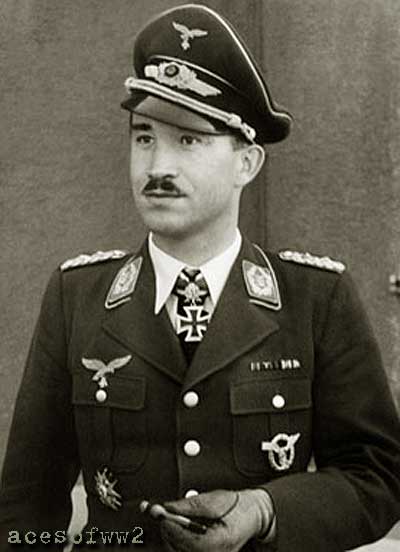|
_________________________________________________
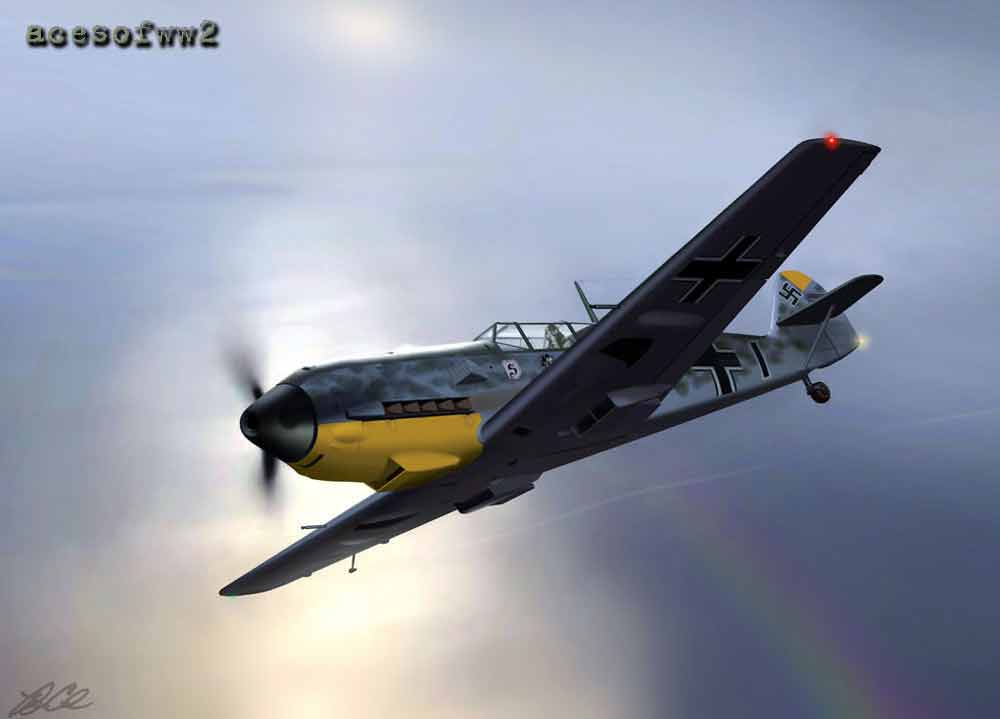
BF109 of Adolf Galland by Ron Cole *
Q- General, please describe your childhood and family life.
A- Sure. I was born in Westerholt, a small village in Westphalia on March 19, 1912, so now I am eighty one years old. I was the second son, Fritz being the oldest, then myself, Wilhelm, and Paul. My father was an administrator of private lands and properties and he was very fair, but harsh. We had the best mother in the world, and during the war she used to pray for fog over our bases so we could not fly.
Q- I know that two of your brothers were combat pilots, which ones were they? Q- What developed your interest in flying? |
 Galland in his cockpit during the Battle of Britain |
I had modified the plane beyond normal limits and slammed into the ground. Everyone thought I was dead and I was in a coma for three days. My parents came and stayed with me until I came out of it. I had serious skull fractures, a broken nose which never looked the same again, and I was partially blinded in my left eye from glass fragments, so I still had to pass the physical.
My C.O., Major Rheitel, a flyer from the First World War assisted me in my goal to return to flying. So, I continued to fly, but a year later I crashed an Arado Ar-68 and again went into the hospital, where they pulled my old file stating that I was grounded.
Well, with many days in the hospital again I memorized every letter and every number, in every possible sequence on the eye chart for my next examination.
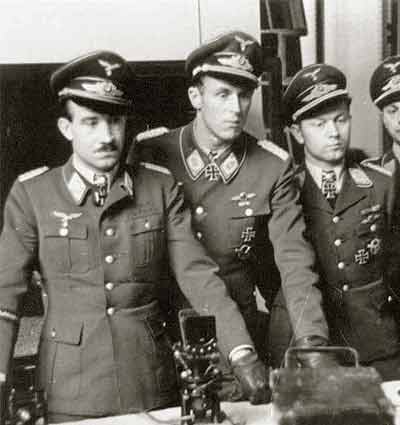 Galland, Hannes Trautloft & Walter Oesau |
You know, to this day I still have some of the glass from the first crash in my eye that has never been totally removed. We left for Spain with the ‘Union Travel Society’ ostensibly bound for Genoa on a tramp steamer. After twelve days we arrived in El Ferrol on 7 May 1937. I had been to Spain before with Lufthansa, and looked forward to returning. Of our groups of men there were many future ace and leaders fighting for Franco’s forces, such as Hannes Trautloft, Wilhelm Balthasar, Eduard Neumann, Guenther Luetzow, and others like Hajo Herrmann who flew as a bomber pilot in Ju-52s. I became a squadron leader in the Legion Fighter Group, and we were equipped with Heinkel He-51 biplanes. Luetzow commanded a squadron of the new Me-109s. Q- What was the Legion’s strength in Spain? Q- What was your first engagement in Spain? Q- Is it true that you often flew in swimming trunks and shirtless? |
Q- You also had your men think about new ways to wage war, such as inventing the method of dropping something similar to napalm, didn’t you?
A- Yes, we filled drop tanks and drums with petrol and oil, using them to great effect. I also thought about having the squadron quartered on a train, since we always had to move from one base to another, that way we would always be mobile. The Spanish Civil War was much like the First World War, not static as far as the air war went, but very fast moving in the air. This was what made the ground war move faster later. We used the trains effectively, the aircraft being flown to their new bases as needed.
Q- This was when you met Werner Moelders, wasn’t it?
A- Yes. I was recalled to Germany in 1938 and he was my replacement. We became good friends and remained so until his death in 1941. He was a good man; very strict with his own conduct and he expected the same of his men. He was a wonderful man.
Q- All of the pilots I have spoken with who knew him had only the highest praise for his leadership ability and compassion.
A- He was the best man the Luftwaffe had, and he also did well in Spain, shooting down fourteen Loyalist aircraft. He went on, as you know to have a total of 114 victories and won the Diamonds as well.
Q- The Franco government decorated you before you left. What awards did they give you? Q- After Spain you and Moelders began creating the fighter arm in Germany. How did that go? Q- Tell us about the war, when it started, and what was your first combat assignment? |
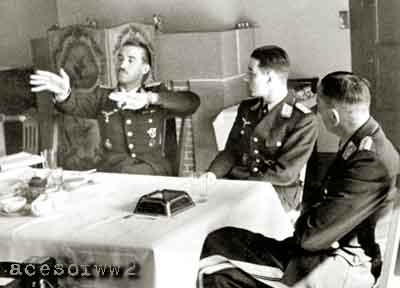 Galland shows Werner Moelders & Theo Osterkamp the moves at Osterkamp's birthday party, April 1941 |
Q- What was your next arena?
A- Oh, the Battle of Britain of course! That was a tough fight, where I was assigned to JG-26 ‘Schlageter’. I became Group Commander of III/JG-26 and shot down two fighters in my first mission with them. I was promoted to major on 18 July 1940 and awarded the Knight’s Cross on 22 August for my seventeenth victory. I then succeeded Gotthard Handrick as Kommodore of JG-26, and received the Oak Leaves from Hitler on 25 September for my fortieth victory. On 1 November I scored my fiftieth kill and was promoted to lieutenant colonel. In December I was a full colonel.
Q- What was the real story behind your Mickey Mouse insignia painted on the fuselage?
A- We started this in Spain, and when I painted it on my Me-109E in JG-26 it was holding a hatchet and smoking a cigar, which I loved, but after the war had to give up.
Q- Is it true you had the only cigar lighter equipped Messerschmitt in the Luftwaffe?
A- I think so, plus a holder for it if I were on oxygen. It created quite a controversy I can tell you.
Q- Describe the first time you were shot down.
A- This was when JG-26 was stationed at Pas-de-Calais; we had attacked some Blenheim bombers and I shot down two, but some Spitfires were on me and they shot my plane up. I had to belly land in a field until picked up later, and I went on another mission after lunch. On this mission I shot down number seventy, but did something stupid. I was following the kill down when I was bounced and shot up badly; my plane was on fire and I was wounded. I tried to bail out but the canopy was jammed shut from enemy bullets, so I tried to stand in the cockpit, forcing the canopy open with my back as the plane screamed towards earth. I opened it and almost cleared the 109 when my parachute harness became entangled on the radio aerial. I fought it with everything I had until I finally broke free, my parachute opening just as I hit the ground. I was bleeding from my head and arm, plus I had damaged my ankle on landing. I was taken to safety by some Frenchmen.
Q- You survived being shot down twice in one day. How did it affect you?
A- I was worried that my wounds might ground me for a long time, which was my greatest concern, not to mention I had lost two aeroplanes.
Q- Tell us the story of Sir Douglas Bader; that has become legendary.
A- He was shot down during a dogfight, and one of his artificial legs was left in the Spitfire when he bailed out, and the other was smashed after he landed. I made a request through the International Red Cross and the British were offered safe passage for the plane to drop them. Well, they dropped them after they bombed my air base. Bader was fitted and sent to a prison camp, and we remained friends until his death a few years ago.
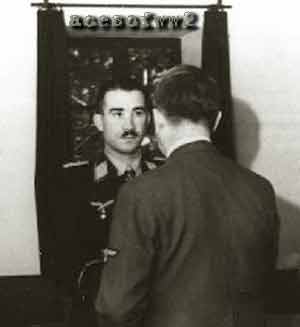 Galland & Hitler |
Q- How did you become General of the Fighters? Q- You organized and commanded the air support for the Scharnhorst and Gneisenau breakout in February 1942. How did that work? Q- So you were still placed in a desk job? Q- That is remarkable. |
Q- Well, all of the pilots think that your appointment as General of the Fighters was the best thing that could have happened to the Luftwaffe, except perhaps if Goering could have been dismissed.
A- Well, it was a big responsibility, and you could never get what you needed. Our fighter force was small and we received no understanding from Goering.
Q- Speaking of Goering, I know you had the most contact with him of all the pilots and you understood his problems. What did you think of him personally?
A- Yes, he had many problems, but he was basically an intelligent man and well educated from the aristocracy.
But he had many weak points in his life and he was always under pressure from Hitler, yet he never contradicted him or corrected him on any point. That was where he made his greatest mistakes. This weakness increased as the war dragged on, along with his drug addiction, until he was nothing. As far as our Luftwaffe was concerned he was even less and should have been replaced.
Q- I do know that in deference to Goering the fighters looked to you for guidance and leadership most of the time.
A- Yes, that was true.
Q- Tell us of your impressions of Hitler, as you spent many months in his company and knew him very well. Q- Do you feel Hitler should have replaced Goering as head of the Luftwaffe long before things became terminal? Q- You knew one man who stood up to Hitler, Reinhard Gehlen. What did you think of him? |
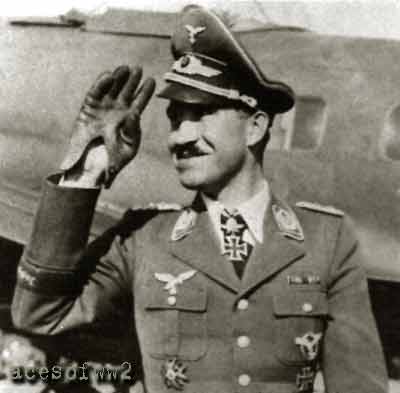 |
Q- Well, of all the men you led and are friends with today, are there any who simply stood out as great leaders despite their records as aces?
A- Oh my, that would be a long list, and you know most of them. All the names you could mention, I think perhaps the greatest leader was still Moelders. All the rest are still very good friends of mine, but we are old men now, and life is not as fast as it was in the cockpit. However, as their leader I also made many mistakes; I could have done better. I was young and inexperienced with life I guess. It is very easy to look back retrospectively and criticize yourself. However, at that time it was very difficult. My situation was that I had to fight with Goering and Hitler in order to accomplish what they wished, but without their support, if that makes any sense. Goering was a thorn in my side and Hitler simply destroyed our country, and others, without any regard for the welfare of others.
Q- What led to the Fighters Revolt in January 1945?
A- Basically the problems we were having with Goering and the fact that he was blaming us, the fighter pilots, for the bombings of Germany and our losing the war. All of the senior Kommodores brought their grievances to me, and we chose a spokesman to represent them. I sat on the panel for the meeting with Goering.
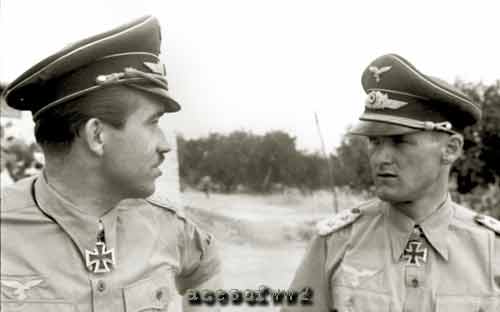 Galland & Gunther Lutzow |
Q- Your spokesman was Guenther Luetzow? Q- What was the atmosphere like, and what were the Kommodore’s opinion of the meeting? Q- One situation I would like to probe was Walter Nowotny. You were at Achmer when he was killed and you saw the interview I conducted with Edward Haydon. What do you recall about Nowotny, and do you feel that his death had any impact on your jet fighter program? |
A- I had been telling Hitler for over a year since my first flight in a Me-262 that only Fw-190 fighter production should continue in conventional aircraft; discontinue the Me-109, which was outdated, and focus upon building a massive jet fighter force.
I was at East Prussia for the preview of the jet, which was fantastic, a totally new development. This was 1943 and I was there with Professor [Willi] Messerschmitt and other engineers responsible for the development. The fighter was almost ready for mass production at that time and Hitler wanted to see a demonstration. The 262 was brought out for his viewing at Insterburg and I was standing there next to him. Hitler was very impressed and he asked the professor ‘Is this aircraft able to carry bombs?’ Well, Messerschmitt said, ‘Yes my Fuehrer, it can carry for sure a 250 kilogram bomb, perhaps two of them.’ In typical Hitler fashion, he said; ‘Well, nobody thought of this! This is the Blitz bomber I have been requesting for years. No one thought of this. I order that this 262 be used exclusively as a Blitz bomber, and you Messerschmitt have to make all the necessary preparations to make this feasible.’ This was really the beginning of the misuse of the 262, as five bomber wings were supposed to be equipped with the jet. These bomber pilots had no fighter experience such as combat flying or shooting, which is why so many were shot down. They could only escape by outrunning the fighters in pursuit. This was the greatest mistake surrounding the Me-262, and I believe the 262 could have been made operational as a fighter at least a year and a half earlier, and built in large enough numbers so that it could have changed the air war. It would most certainly not have changed the final outcome of the war, for we had already lost completely, but it would have probably delayed the end since the Normandy invasion would probably not have taken place, at least not successfully, if the 262 had been operational. I certainly think that just 300 jets flown daily by the best fighter pilots would have had a major impact on the course of the air war. This would have of course prolonged the war, so perhaps Hitler’s misuse of this aircraft was not such a bad thing after all. But about Nowotny…
Q- Yes, how did you come to choose him? Q- What were the initial results? Q- What brought you to Achmer on 8 November 1944? |
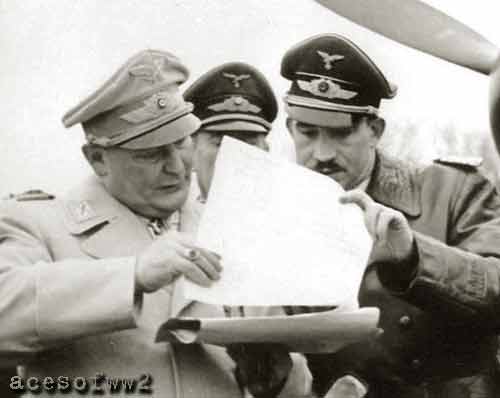 Hermann Goring & Galland |
The defensive anti-aircraft battery opened fire on a few P-51 Mustangs that approached the field, but they were chased away from what I could understand, and the jets were coming in. One had been shot down and Nowotny reported that he had made ‘his third kill, one of his engines was damaged;’ he was flying on one engine alone that made him vulnerable. I stepped outside to watch his approach to the field when an enemy fighter pulled away not far from us. I heard the sound of a jet engine, and we saw this 262 coming down through the clouds at low altitude, rolling slightly and then hitting the ground. The explosion rocked the air and only a column of black smoke rose from behind the trees. We took off in a car and reached the wreckage, and it was Nowotny’s plane. After sifting through the wreckage, the only salvageable things found were his left hand and pieces of his Diamonds decoration.
Q- How did that impact upon the progress report to Hitler concerning the jet fighters?
A- Hitler, from what I understand was upset about his loss, but I don’t think that he really said anything about it to me. Well, the remains of that unit went to form JG-7, commanded by our friend Johannes Steinhoff. Steinhoff recruited other great aces such as Rudorffer and others to command the various groups.
Q- After you were fired as General of the Fighters, they replaced you with a man whom the fighter pilots did not respect, correct?
A- Yes, Gordon Gollob, and he was not well liked, although he was a great pilot with the Diamonds, but he had no character. He was not Goering’s first choice; Hajo Herrmann was also being considered and he would have been a better selection. When I was released as General of the Fighters Goering was preparing a coup against me, and when Hitler learned of this he ordered Goering to stop the actions against me. Hitler ordered my replacement, but allowed me to form my own 262 unit, basically allowing me to keep my rank but reducing my responsibilities.
 |
Q- How did you feel about once again becoming a squadron leader, where you started? Q- Tell us about April 26; that was your last flight, wasn’t it? |
Suddenly my instrument panel disintegrated; my canopy shattered and my right knee was struck. I was losing power and in great pain. I thought about parachuting out, but realized that might be dangerous, as some of our pilots had been strafed upon exiting their jets. I cut the power to my good engine and thumped across the field, my nose wheel had been flattened and smoke was pouring from my plane. I climbed out to get away in case it should explode, only to find aircraft dropping bombs and firing rockets at me.
Well, our mission netted five victories total and none of the pilots killed. From this point forward Baer took over operational command and every unit in Germany with jets began bringing them to us at Reims. For such a long time I had been begging for planes, now that the war was almost over I had more planes than men to fly them.
Q- You were there when Steinhoff crashed. What do you remember?
A- Several of us; myself, Steinhoff, Barkhorn, Schallmoser, Faehrmann, Krupinski and Klaus Neumann were taking off on a mission shortly after our base had been attacked, and his [Steinhoff’s] 262 hit a crater made from a bomb. His jet lifted into the air but without sufficient take-off speed, then he nosed in and exploded. We returned to base to find him carried to the hospital more dead than alive. The fact that he survived is the most incredible thing, and I am glad he did, for he is one of my closest friends today.
Q- When you were captured and released from prison you went to Argentina with other aviation experts. Tell us about that.
A- Juan Peron wanted German experts to build his air force, and I was asked to come along with others. I went and established a training and operations school, developed their tactical training program, and was able to fly again in some of the new designs purchased by Argentina. I really loved that period; it was one of the happiest of my life. Kurt Tank came and he was the one who convinced President Peron to bring me over. I did that until 1955 when I returned to Germany and entered the business world, consulting and getting my life together.
Q- Well, as you probably know the Argentine Air Force was still using much of your doctrine as late as the Falklands War, with great effect. Q- Tell us about your children? Q- You have a wonderful family, and I know you are very proud of them. |
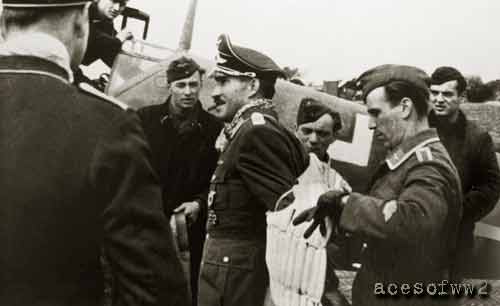 |
_________________________________________________
Victories Include :
104
Details of victory claims can be found on this page at luftwaffe.cz
_________________________________________________
Back to --- German Aces --- |
_________________________________________________
Thanks go out to
Colin Heaton & Cy Lufkin of The House of Gutenberg for the use of this interview
On these pages I use Hugh Halliday's extensive research which includes info from numerous sources; newspaper articles via the Canadian Museum of Civilization Corporation (CMCC); the Google News Archives; the London Gazette Archives and other sources both published and private.
|
Some content on this site is probably the property of acesofww2.com unless otherwise noted.
![]()

